BLDG25
Building an app fast
For this sales demo, our team of a product owner, designers, experts, and engineers was asked to tackle an ambitious challenge: Build a demo experience that envisions a future state where we would have access to all data coming in from apps built on top of Apple and Google APIs. The goal was to create an immersive experience where users would have access to an intelligent system that delivers key insights to aid human decision making.
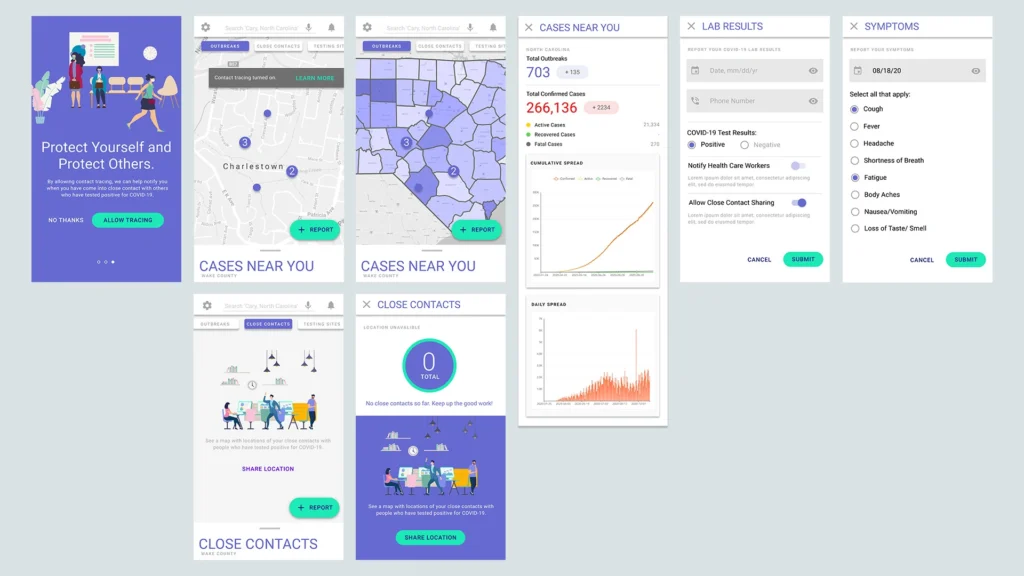
Day 1
Mapping out the challenge
Using the exercises from the design sprint process, our team rapidly formed the sprint questions, identified target users, and outlined key challenges. This initial day of work helped everyone build a shared understanding and define the challenge.
Target challenge:
Design a future-state contact tracing mobile app that leverages Apple and Google APIs to deliver intelligent insights for both public health officials and individual users.
Target users:
- Primary: Public Health Officials
- Secondary: Contact Cases/Patients
Sprint questions:
- How might we create realistic data models that show contact connections and predict virus spread?
- How might we classify multiple risk elements for infections similar to cybersecurity risk models?
- How might we support different user personas while maintaining privacy?
Key hurdles:
- Creating realistic data visualization from API inputs
- Balancing comprehensive tracking with privacy concerns
- Supporting multiple user perspectives
- Implementing predictive modeling for virus spread
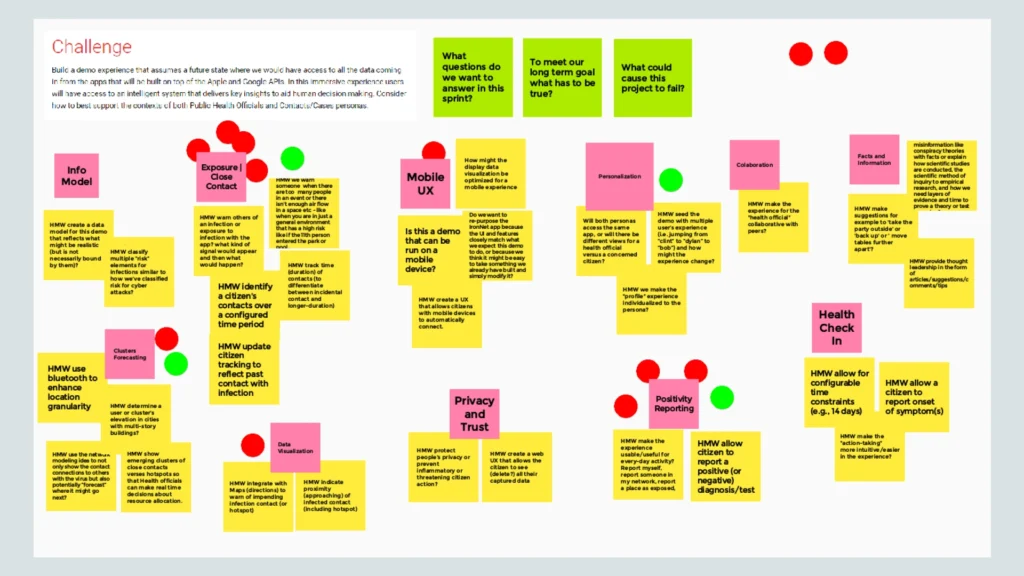
Sketching solution concepts
With a clear definition in place, we used the afternoon to explore solutions. The team produced an amazing set of concepts to consider.
Network Modeling Features:
- Contact connection visualization
- Predictive spread patterns
- Risk level indicators
User Experience Variations:
- Public health official dashboard
- Patient notification interface
- Privacy settings management
Risk Classification System:
- Multi-factor risk assessment
- Real-time updates
- Actionable alerts
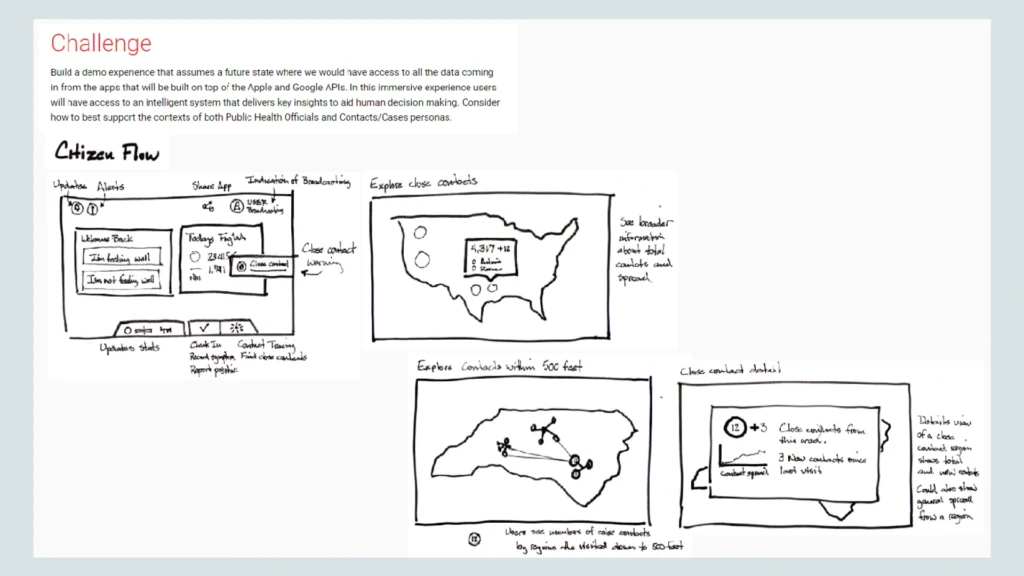
Day 2
Voting and Storyboarding
On the morning of the second day, we began with a heat map vote, allowing participants to mark their favorite parts of all the solutions. Each solution was then presented by our facilitator for review. Following this, we conducted a straw poll, where each team member voted for the solution they felt had the most overall potential. The final decision was made through a “decider vote,” where our designated decider selected a couple of concepts for further development in the storyboard.
In the afternoon, we created two user testing flows to structure and align our storyboard with the sprint questions. This framework allowed us to efficiently begin sketching and assembling the storyboard in the remaining time. The team concentrated on two key activities: self-reporting test results and exploring a close contact map. In the process, we also identified related elements that supported these concepts:
- Network Visualization Dashboard
- Risk Classification System
- Persona-Specific Interfaces
- Privacy-Focused Notifications
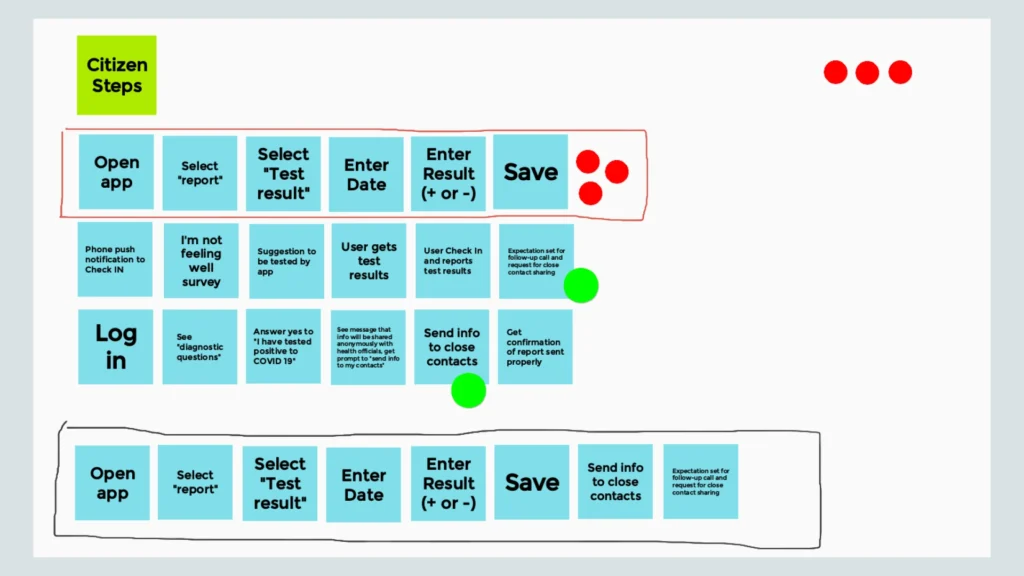
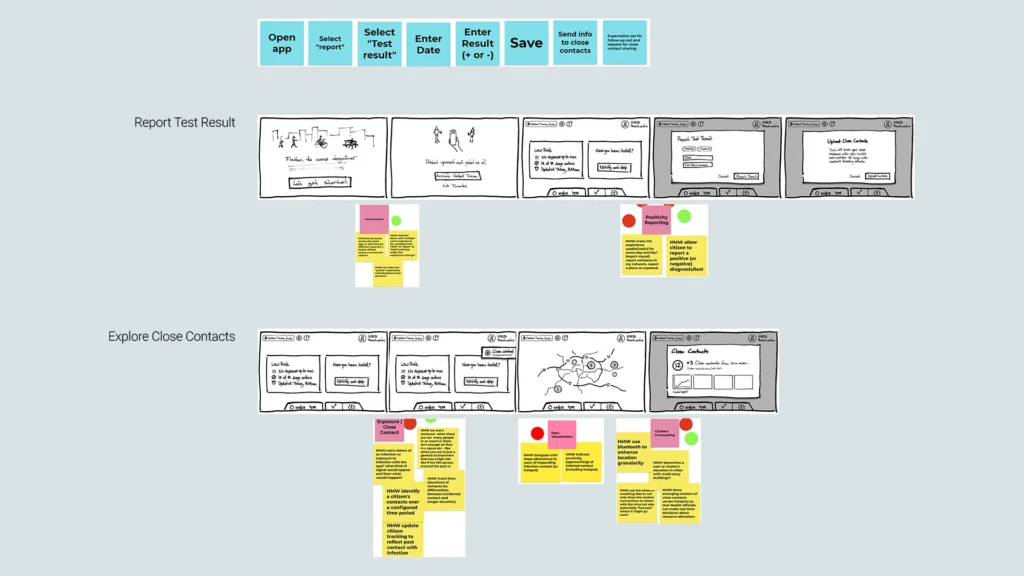
Day 3
Prototyping
Voting and StorOur team moved swiftly into the rapid prototyping day, led by our Senior UX Designer and Interaction Designer. Within just one day, we developed an initial prototype in Figma, using the Material Design System to ensure consistency and efficiency. The prototype was centered around core functionality and key user flows, giving us a tangible product to test and iterate upon. By focusing on these essential elements, we were able to build a robust foundation for testing user interactions and gathering critical feedback in the early stages of development.
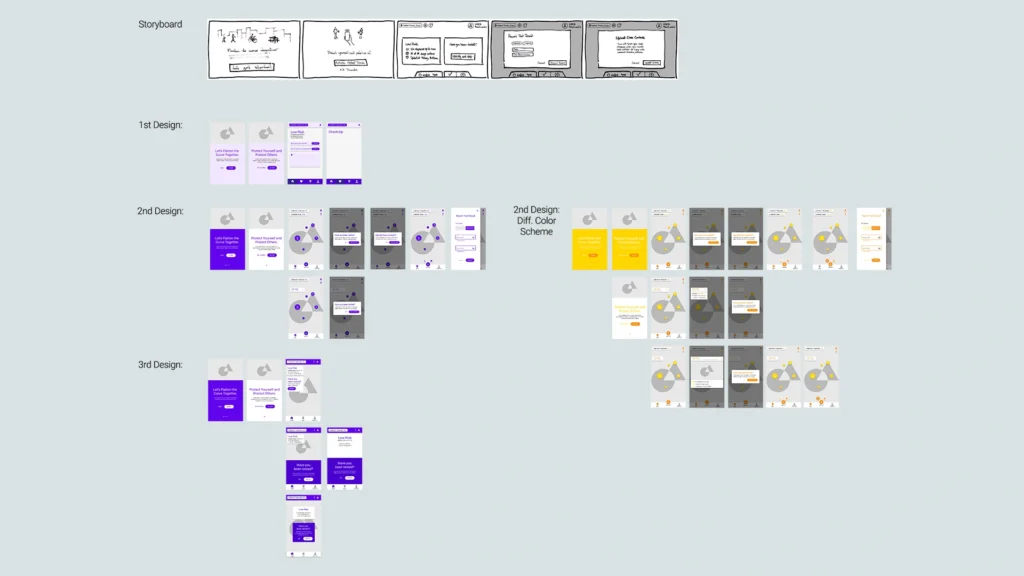
Day 4
Testing and validation
On the day of user testing, our team conducted online moderated sessions with representative users. The senior UX designer led the interviews, while other members of the design and product team silently observed and took notes. We used a preconfigured digital whiteboard in Miro, organized with columns for each user and rows for task steps and screens. Observers captured their insights using color-coded sticky notes to represent positive, negative, or neutral sentiments. Throughout the tests, we gathered valuable feedback on the core functionalities and collected quantitative data to assess whether users felt the solution effectively addressed each sprint question. This process provided both qualitative and quantitative insights, which were easy to map and tally in preparation for an upcoming review meeting with the entire team.
Weeks 2 and 3
Iterating and enhancing
In the second and third weeks of development, we focused on iterating and enhancing the prototype. During a team review meeting, we analyzed the user test board, incorporating new research insights to decide which areas of the user flows needed improvement. The product and design teams then made another round of adjustments, refining user flows, enhancing visual elements, expanding task capabilities, and strengthening privacy features. We also conducted a second set of user tests to validate these changes. Simultaneously, the engineering team began building the mobile app in Flutter. By the end of week three, we had a fully functional app ready for sales demos.
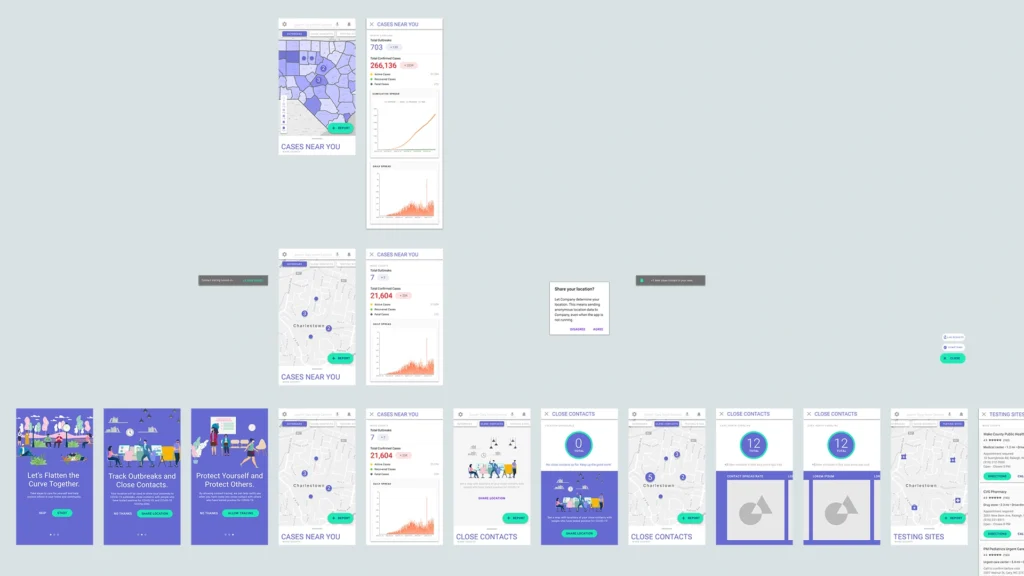
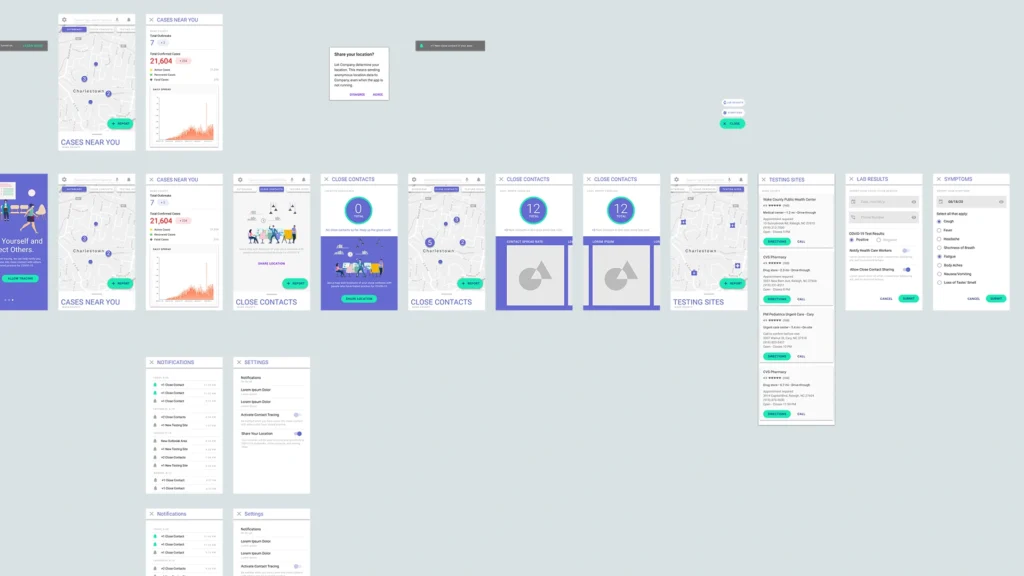
Results and insights
Reflecting on our achievements
In this project, our goal was to design a future-forward contact tracing system that could leverage advanced technology while ensuring user privacy and supporting public health initiatives. Over the course of three weeks, we worked through a design-thinking process, using a sprint approach to quickly generate and validate solutions. The resulting interactive prototype highlighted how privacy-first mechanisms could be seamlessly integrated into a robust, public health-supporting system.
Our approach followed a structured design-thinking framework, encompassing six key phases: empathize, define, ideate, prototype, test, and implement. These phases allowed us to deeply understand user needs, explore innovative solutions, and materialize them into a functional prototype. Deliverables included a fully interactive prototype, developer handoff documentation, and an initial Flutter app build, all completed within the tight three-week timeline.
Throughout the sprints, we gained valuable insights into both design and technology. The design sprint method proved particularly useful for rapid problem-solving in complex environments, quickly validating future-state concepts, and aligning stakeholders. We also learned the importance of balancing functionality with privacy and how realistic data modeling and persona-based design play a crucial role in developing user-centered solutions.
Our team’s success was underpinned by strong collaboration between design and development. Rapid prototyping allowed us to compress the typical design cycle, and the synergy between design and technical teams led to efficient handoffs and implementation. This project demonstrated the value of a user-centered process and how design sprints can be used to address real-world challenges with speed and precision.